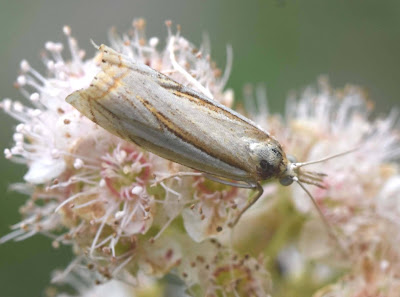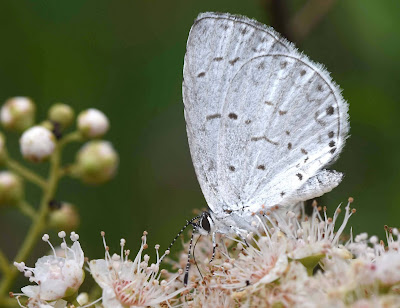 |
| Spring Azure on a budding meadowsweet shrub Spiraea alba |
Butterflies and flowers have formed a couplet in my mind since an early age. I expected to see them abundantly paired on the meadowsweet shrubs currently in bloom, but the nectar so delectable to many winged insects has seldom attracted butterflies. That scarcity reflects concerns about worldwide population declines of Lepidoptera.
 |
Gray Hairstreak butterfly |
Lepidoptera, the taxonomic order of butterflies and moths, encompasses one of our most beautiful and recognizable insect groups. Its name derives from the Greek words for 'scale' and 'wing'. The minute scales that cover their bodies, often in colorful patterns, distinguish Lepidoptera from all other animal forms.
 |
Grapeleaf Skeletonizer moth |
Many of us have a hunch about distinctions between butterflies and moths, but as we learn more the exceptions undermine attempts at firming the categories. Absolute classification has proven elusive under the lens of modern scientific research. For generalists like you and me antenna shape is a helpful guide. In the first two photographs above butterflies show their typical filaments, segmented and ending in a club. They contrast with the moth in the third photograph with feathery antennae, quite plume-like in this case. A glimpse of the antennae will usually (but not always) get you on the right track in separating butterflies from moths.
 |
An inconclusive subject, nevertheless a moth |
Very often moths at rest fold their wings back over their abdomens rather than extending them upright or to the side like many butterflies. Very often moths present a chunkier appearance than butterflies.
Here in Massachusetts there are many more species of moths than butterflies, that we seldom see because they are commonly nocturnal. Nighttime activity gives advantage to drab coloration and to markings that aid camouflage by day, whereas bright pigmentation frequently seen on butterflies may warn predators of a day flyer's inherent or mimicked toxicity. But not all moths and butterflies fall neatly into these patterns.
Unlike butterflies, a moth's forewings are joined to its hind wings by coupling mechanisms to help the wings work in unison during flight.
Most Lepidoptera larvae (caterpillars) construct protective coverings within which they metamorphose to the pupal stage. Moth larvae almost always make cocoons, wrapped in a silk covering, while butterfly larvae make a hard, smooth chrysalis with no silk covering.
Butterflies and moths tend to have different types of compound eyes. Most moths' eyes function well in low light environments. Butterfly vision typically emphasizes acute resolution and color perception that are more advantageous in daytime.
 |
Spring Azure butterfly |
Meadowsweet shrubs host the Spring Azure in both its adult and larval phases. This species' wings present a lovely fleeting blue in flight that is rarely visible when the butterfly is perched.
 |
Namesake azure on an upper wing surface |
Springtime Azures are followed by successive generations
throughout the summer, often with slightly different markings that stimulate
discussion on sorting them within the "Spring Azure Complex." One
website of The North America Butterfly Association quips that "all it
takes for a spirited argument are two taxonomists and one azure." What is
inarguable is delight at the startling brilliance fluttering by.
Beautifully written and photographed!
ReplyDelete